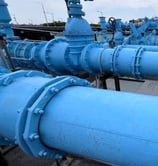Smart Water Pump🤖Management AI Platform ── Cut Energy, Water & Labor Costs
Transform any water facility – from industrial plants to pumping stations. One solution handles all your water supply management needs. Achieve 20 - 30% efficiency gains and dramatically reduce electricity bills by millions annually!
Critical Water Management Challenges
Pump systems operate far below optimal performance, causing massive energy waste that directly impacts your bottom line.
Energy Efficiency Crisis
Skyrocketing Maintenance Costs


Poor operating conditions dramatically shorten equipment life, forcing costly emergency repairs and premature replacements.

Resource-Intensive Manual Operations
Water equipment monitoring consumes valuable staff time while increasing the risk of costly human errors and operational oversights.

Inability to Optimize Water Flow
Manual operations rely on guesswork and personal habits, making it impossible to adjust in real-time or respond efficiently to changing water demands.

Operational Safety Risks
Poor manual control creates pressure surges that damage infrastructure and disrupt reliable water supply, especially during critical situations.
✅ Works with any brand of pumps, VFDs, sensors, and PLC/SCADA systems. Zero hardware lock-in eliminates costly equipment replacement expenses.
✅ Start with a single pump or station, then expand at any pace with complete flexibility and seamless scaling.
No Hardware Lock-In
Flexible Implementation from Small to Large Scale
AquaOptima 水智優 -
Your Smart Management AI Platform






✅ Optimizes pump performance and supply precision to eliminate water waste, dramatically reducing electricity expenses.
✅ 24/7 automated control reduces manual labor demands and eliminates on-site operational burdens.
✅ System costs just 1/3 of international solutions while delivering superior performance and unmatched ROI.
✅ Achieve 15 - 30% energy reductions, save millions annually in electricity costs, with typical payback in just 1.7 - 2.5 years.
Cut Energy, Water & Labor Costs
Low Investment, High Returns
Rapid Investment Recovery
Three Smart Modules Set
New Efficiency Standards
Water Pressure Monitoring : Installed at main pipelines and pump outlets to provide real-time pressure data and system performance tracking
Flow Measurement : Monitors water output every second, enabling precise control of demand fluctuations and optimal supply management
Power Monitoring : Tracks pump energy consumption and operational parameters to identify efficiency improvements and cost-saving opportunities
Automated VFD Control : Remotely adjusts pump frequency and start/stop operations through standard industrial protocols for seamless integration
SCADA/PLC Integration : Connects with existing monitoring systems, consolidating all sensor and control data into the AquaOptima cloud platform with real-time updates (≥ 1 per second)
IoT Integration
Seamlessly connects pumps, VFDs, and sensors with existing SCADA/PLC systems, creating intelligent data flow and automated control for smart energy optimization.
Complete Data Collection & Control
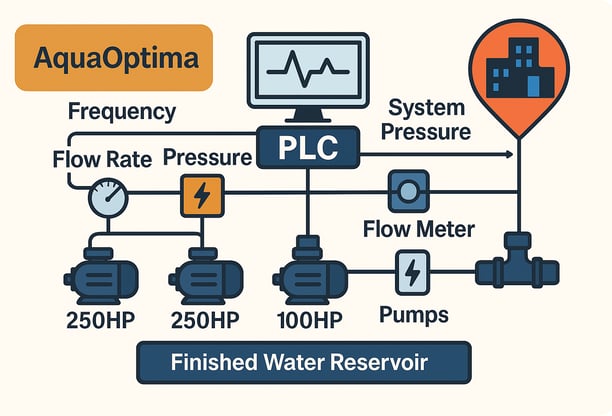

Water Management Platform
Complete monitoring, operation, management and recording capabilities that serve as the digital command center for field operators and management personnel.
Dashboard : Dedicated interface displays real-time pump status, supply targets and performance trends for instant operational visibility.
Alerts : Automatically delivers 14 types of critical notifications with read confirmations and action tracking for proactive maintenance.
Data Export : Filter and quickly export system data, alerts and intelligent control records for comprehensive reporting and analysis.
Supply Target Management : Set pressure and flow parameters with automated scheduling and manual override capabilities for optimal control.
Asset Management : Track pump specifications and equipment status with real-time updates (operating / standby / maintenance / retired) for efficient fleet management.
Smart Logs : Complete minute-by-minute records of data inputs, control commands and AI decisions for full operational transparency.
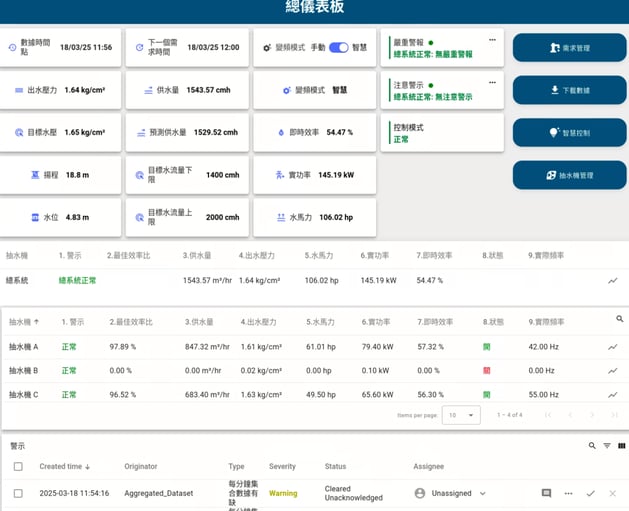

Six Powerful Platform Features
Equipment Analysis : Pump performance models and pump efficiency models
Demand Forecasting : Water demand models and system curve models
Optimization Control : Optimal pump combinations and frequency with multi-objective optimization pump control logic
AI Intelligence
Three-layer AI brain (equipment / demand / control) delivers stable pressure control and highly efficient energy-saving automated scheduling strategies.
Three-Layer AI
Proven Performance Advantages
Minimal Initial Data : Requires only small amounts of data for rapid model building and immediate results
High Precision : Delivers stable pump efficiency optimization with reliable performance improvements
High Adaptability : Algorithms easily expand to other facilities and operational scenarios
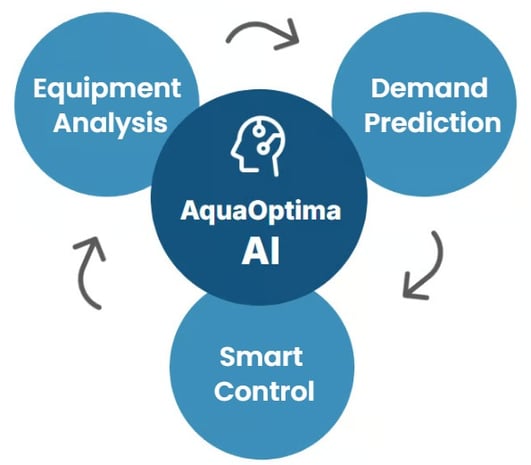

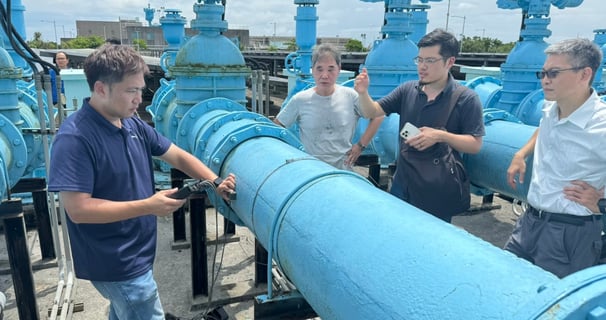

Traditional operations kept main pumps at fixed frequency or intermittent variable speed, dropping efficiency to just 70%. Auxiliary pumps ran even further below optimal points, creating overall system efficiency of only 41%. This caused massive energy waste, accelerated equipment wear, and required constant manual monitoring - consuming substantial labor and maintenance costs.
Less Water Waste + Better Energy Efficiency = Lower Power Consumption
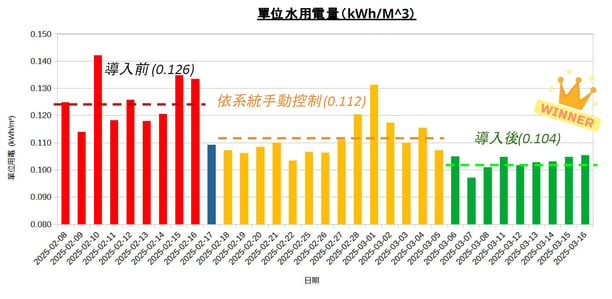

Success Story -
Taiwan Water Corporation Qingzhou Water Treatment Plant


The Challenge :
Proven Energy Savings Results:
After 15 days of testing and 45 days of stable operation, the system successfully delivered these verified benefits:
✅ Electricity consumption per unit of water dropped 17.7%, overall energy savings reached 20 - 30%
✅ Pump efficiency improvements of 5 - 20%, effectively extending equipment lifespan
✅ Daily labor savings of 1 hour+ in manual operation time
✅ 95%+ precision in water supply management, eliminating over- or under-supply issues
✅ 100% automated operation accuracy within set parameters
During operation, main pump efficiency consistently maintained > 90%
(100% = optimal operating condition)


The Solution :
After implementation, unit water electricity consumption dropped significantly compared to pre-installation levels
The water treatment plant consumes 1.66 million kWh annually. With 20% energy savings at NT$4 per kWh, this saves up to NT$1.32 million annually!
AquaOptima AI connects sensors and pumps through smart IoT integration, using three-layer artificial intelligence for automatic optimization. The system delivers 24/7 intelligent pump control, dramatically improving efficiency while eliminating manual monitoring and significantly reducing energy costs and equipment wear.
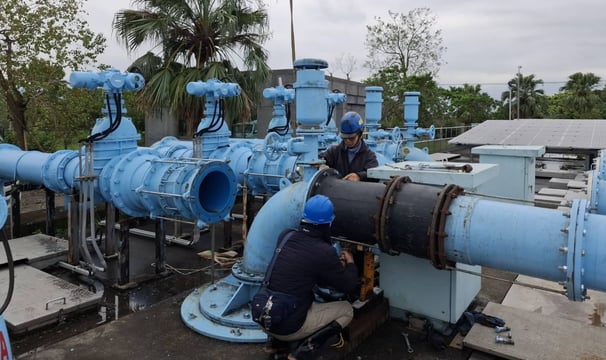

Our team conducted actual site visits to Qingzhou Water Treatment Plant for comprehensive assessment
Installed monitoring equipment and integrated with existing systems
Works seamlessly with local software and hardware systems. Full Chinese interface reduces training barriers. Domestic development ensures better security and superior cost-effectiveness.
Domestic
Development
Water Management Technology Transfer - Smart Local Engineering

Tailored
Solutions
Long-Term
Support
Deep understanding of on-site processes and operational habits. AI intelligence integrates directly into control logic for smooth implementation.
Local teams provide immediate online and on-site response. Long-term partnership ensures comprehensive problem resolution and ongoing maintenance support.


Frequently Asked Questions
How does AquaOptima read and control existing pumps?
The system connects seamlessly with existing SCADA or PLC/PAC systems using standard MODBUS/OPC protocols. It reads water pressure, flow, power, and frequency sensor data while sending start/stop and frequency control commands automatically – no hardware replacement needed.
What applications is the system suitable for?
Perfect for factories, pumping stations, wastewater treatment plants, and any facility with variable or fixed frequency pumps. Modular design allows starting small and expanding gradually.
Does installation require downtime or changes to existing processes?
No plant-wide shutdown needed. Installation only requires adding pressure meters, flow meters, and electrical sensors during testing. Everything else connects through existing PLC/SCADA systems with minimal disruption to daily operations.
How do you handle maintenance and upgrades?
We provide monthly performance reports, system health checks, and operator training. Continuous improvements to algorithms, demand management functions, and UI/UX ensure long-term stable operation and ongoing efficiency gains.
Why is VFD more energy efficient than fixed frequency operation?
Fixed frequency pumps cannot adapt to actual site conditions and flow demands, so they frequently operate away from Best Efficiency Point (BEP) and waste significant energy. VFDs automatically adjust frequency in real-time, precisely matching on-site pressure and flow changes. This keeps pumps in the 90%+ efficiency range while reducing energy consumption and water hammer risks.
How to quantify and verify Energy Savings?
Electricity per Unit of Water (kWh/m³):Compare power required for equivalent water output before and after implementation. Our POC reduced consumption by 17.7% (from 0.126 to 0.104 kWh/m³).
Overall System Efficiency:Calculated as pump efficiency × motor efficiency × VFD efficiency. POC improved from 41% to 51% - that's a 22% overall increase.
Direct Power Monitoring:Record daily kWh consumption, directly comparing traditional manual, semi-automatic, and fully automatic operation phases. This verified 20 - 30% energy savings.
How does multi-objective optimization work?
Our AI converts multiple targets - site conditions/pressure goals, flow requirements, efficiency maximization, and switching frequency/combination stability - into mathematical functions. Using proprietary multi-objective optimization algorithms (similar to multi-objective PID + MIP), the system solves for optimal pump combinations and frequencies in real-time.
How much data does the System need?
Minimum:Two weeks of continuous operation data, including minute-by-minute water pressure, flow, pump frequency, and current/power readings. Manual operation logs recommended for system calibration.
Best Results:1 - 2 months of comprehensive data improves model stability and scenario coverage, especially during extreme peak and low-demand periods.
How do you measure Pump Efficiency Ratio (ER)?
ER Formula: ER = Actual operating efficiency ÷ Best Efficiency Point (BEP) efficiency of that specific pump model.
Measurement Process: First obtain BEP efficiency from field testing or manufacturer performance curves, then measure actual operating conditions for power and hydraulic output comparison. During our POC, all pump groups maintained ER ≥ 90% consistently long-term.
Why are there 14 alert types?
Water supply systems have complex operational components, from sensor data anomalies and algorithm optimization failures to PLC/PAC communication interruptions and control command execution errors. Each component can cause efficiency drops or downtime risks. Our 14 alert types cover all critical monitoring points, ensuring immediate detection and resolution of any issues.
📩 Professional Feasibility Assessment Service
Starting at NT$180,000
Pricing customized based on facility complexity and project requirements.
(tax included)
✅ Initial Potential Assessment: Quick evaluation of electricity cost savings percentage and energy reduction opportunities
✅ On-Site Data Collection: Analyze pump specifications, water pressure / flow patterns, and power consumption profiles
✅ Feasibility Report: Quantified energy savings, payback timeline, and phased optimization recommendations
Key Service Features
See your energy savings potential and ROI clearly before making any investment!






